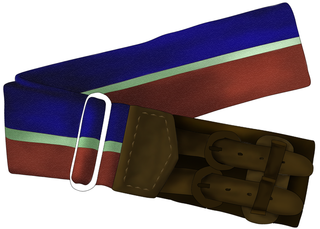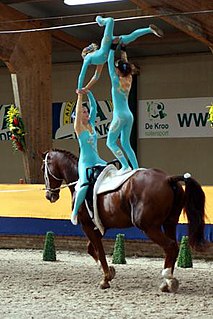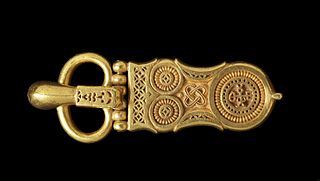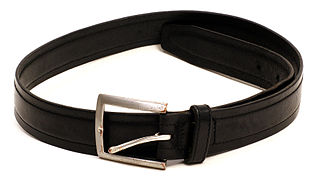
A quiver is a container for holding arrows, bolts, or darts. It can be carried on an archer's body, the bow, or the ground, depending on the type of shooting and the archer's personal preference. Quivers were traditionally made of leather, wood, furs, and other natural materials, but are now often made of metal or plastic.

Bronc riding, either bareback bronc or saddle bronc competition, is a rodeo event that involves a rodeo participant riding a bucking horse that attempts to throw or buck off the rider. Originally based on the necessary horse breaking skills of a working cowboy, the event is now a highly stylized competition that utilizes horses that often are specially bred for strength, agility, and bucking ability. It is recognized by the Professional Rodeo Cowboys Association (PRCA) and the International Professional Rodeo Association (IPRA).

Suspenders or braces are fabric or leather straps worn over the shoulders to hold up trousers. The straps may be elasticated, either entirely or only at attachment ends, and most straps are of woven cloth forming an X or Y shape at the back. Suspenders are typically attached to trousers with clips or buttons using leather tabs at the ends.

Chaps are sturdy coverings for the legs consisting of leggings and a belt. They are buckled on over trousers with the chaps' integrated belt, but unlike trousers they have no seat and are not joined at the crotch. They are designed to provide protection for the legs and are usually made of leather or a leather-like material. Their name is a shortened version of the Spanish word "chaparreras." Chaparreras were named after the chaparral from which they were designed to protect the legs while riding on horseback. Like much of western horse culture the origin of chaparreras was in Nueva España/New Mexico and has been assimilated into cowboy culture of the American west. They are a protective garment to be used when riding a horse through brushy terrain. In the modern world, they are worn for both practical work purposes and for exhibition or show use. Chaps have also been adopted for use on motorcycles, particularly by Harley riders and other cruiser style motorcycle riders.

A stable belt is an item of uniform used in the armed forces of Denmark, the United Kingdom and other Commonwealth countries. Gymnastic belts are similar coloured belts used in Brazil and Lebanon.

A belt is a loop of flexible material used to link two or more rotating shafts mechanically, most often parallel. Belts may be used as a source of motion, to transmit power efficiently or to track relative movement. Belts are looped over pulleys and may have a twist between the pulleys, and the shafts need not be parallel.

Western wear is a category of men's and women's clothing which derives its unique style from the clothes worn in the 19th-century Wild West. It ranges from accurate historical reproductions of pioneer, mountain man, Civil War, cowboy and vaquero clothing to the stylized garments popularized by singing cowboys such as Gene Autry and Roy Rogers in the 1940s and 1950s. Western wear can be very informal, with a t-shirt and blue jeans forming a basic ensemble, or it may consist of tailored formal garments with western accents. At minimum, western wear generally incorporates a cowboy hat, a leather belt, and cowboy boots.

Equestrian vaulting, or simply vaulting, is most often described as gymnastics and dance on horseback, which can be practiced both competitively or non-competitively. Vaulting has a history as an equestrian act at circuses, but its origins stretch back at least two-thousand years. It is open to both men and women and is one of ten equestrian disciplines recognized by the International Federation for Equestrian Sports. Therapeutic or interactive vaulting is also used as an activity for children and adults who may have balance, attention, gross motor skill or social deficits.

A surcingle is a strap made of leather or leather-like synthetic materials such as nylon or neoprene, sometimes with elastic, that fastens around the horse's girth.

Side reins are equipment used when longeing a horse, running from the bit of the bridle to the saddle or surcingle. As a horse training tool, they encourage flexion and softness in the horse's mouth. For longe line work with a rider up who does not carry ordinary riding reins, they help calm and settle the animal. However, they are a tool best used by experienced handlers; used improperly they may unduly restrict the horse's movement or cause an accident.

Reins are items of horse tack, used to direct a horse or other animal used for riding. They are long straps that can be made of leather, nylon, metal, or other materials, and attach to a bridle via either its bit or its noseband.

A belt buckle is a buckle, a clasp for fastening two ends, such as of straps or a belt, in which a device attached to one of the ends is fitted or coupled to the other. The word enters Middle English via Old French and the Latin buccula or "cheek-strap," as for a helmet. Belt buckles and other fixtures are used on a variety of belts, including cingula, baltea, baldrics and later waist-belts.

A girth, sometimes called a cinch, is a piece of equipment used to keep the saddle in place on a horse or other animal. It passes under the barrel of the equine, usually attached to the saddle on both sides by two or three leather straps called billets. Girths are used on Australian and English saddles, while western saddles and many pack saddles have a cinch, which is fastened to the saddle by a single wide leather strap on each side, called a latigo.
Dooney & Bourke is a company specializing in fashion accessories, such as handbags, luggage, bracelets, watches, and briefcases, as well as a limited clothing line, which includes sweaters, shoes, jackets, and scarves. While most products are made for women, there are some products, such as sweaters, belts, wallets, briefcases, and some shoes made for men. Founded in 1975, Dooney & Bourke products range from $60–$850.

The saddle is a supportive structure for a rider or other load, fastened to an animal's back by a girth. The most common type is the equestrian saddle designed for a horse. However, specialized saddles have been created for oxen, camels and other creatures. It is not known precisely when riders first began to use some sort of padding or protection, but a blanket attached by some form of surcingle or girth was probably the first "saddle", followed later by more elaborate padded designs. The solid saddle tree was a later invention, and though early stirrup designs predated the invention of the solid tree. The paired stirrup, which attached to the tree, was the last element of the saddle to reach the basic form that is still used today. Today, modern saddles come in a wide variety of styles, each designed for a specific equestrianism discipline, and require careful fit to both the rider and the horse. Proper saddle care can extend the useful life of a saddle, often for decades. The saddle was a crucial step in the increased use of domesticated animals, during the Classical Era.

The Australian Stock Saddle is a saddle in popular use all over the world for activities that require long hours in the saddle and a secure seat. The saddle is suitable for cattle work, starting young horses, everyday pleasure riding, trail riding, endurance riding, polocrosse and is also used in Australian campdrafting competitions and stockman challenges.

A horse harness is a type of horse tack that allows a horse or other equine to be driven and to pull various horse-drawn vehicles such as a carriage, wagon or sleigh. Harnesses may also be used to hitch animals to other loads such as a plow or canal boat.
A bitting rig or bitting harness is a training tool for horses that can teach a horse to accept a bridle and bit, and later assist a horse in developing the necessary musculature for a given equestrianism discipline. Generally used in conjunction with training on a longe line, it is most often seen in the training of Saddle seat horses, but also is used by some dressage trainers and as a tool to start horses in driving.

The 1908 Pattern Web Infantry Equipment was an innovative type of webbing equipment adopted by the British Army before World War I.




















